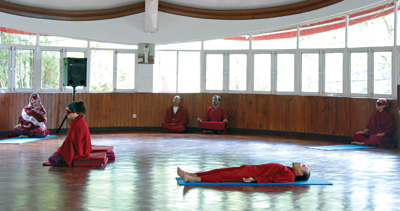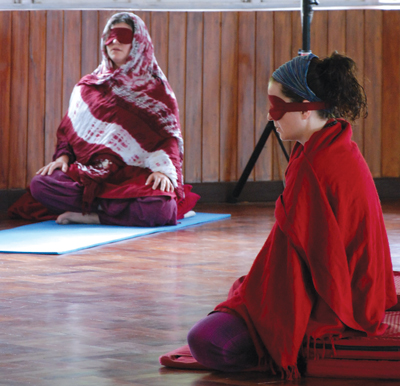The purpose of meditation is to make oneself a bridge to connect with the higher self, a boat to reach the shore on the other side where one comes in contact with the supreme and to turn oneself into a key to unlock the doors to the ‘source’. It is a process of dissolving into cosmic energy and being a part of the rhythm of universal harmony by attuning oneself to the forever-spawning cosmic music.
It is a process of being part of the ‘metaphysical ecosystem’.
Just imagine the abundance of pleasure that would soak your spirit when you become a part of such harmony by considering the short-lived pleasure you get from listening to well composed music or watching breathtaking natural scenery. Think of the ecstasy of positive vibes that will throb through your entire body; the lightness your body will attain after all negative emotions are either dissolved or burnt by a fiery awareness and the radiance your body will exude after your entire being is purified.
The most ironic and encouraging albeit disheartening fact is that, all this is possible only in human life. That is why, for those who are even slightly aware of this possibility, failing to move towards one’s spiritual potential is deeply frustrating.
Given the turn our lifestyles have taken, very few of us are likely to be able to wade through the maze of distractions to attain anything significant on the spiritual journey. The spiritual bliss we often hear about is not possible to attain through a few hours of contemplation or by sitting cross-legged with our eyes closed.
As hectic and distracting as our lives are, anybody aspiring to reach any deeper or higher in meditation to connect with the “source”, needs a proper environment.
 Outward and inward peace
Outward and inward peace
Peace, both outward and inward, is quintessential for any serious attempt. Inward peace of course, depends initially on what goes on, on the outside and therefore outward peace becomes a prerogative for beginners. It is only after we build a sort of fort around ourselves so that no distraction can penetrate or after we turn ourselves into an island so that everything sinks into an ocean of peace around us, does the outward cease to matter.
Interestingly, moving inward is not possible until one truly and totally experiences the outward, because the ultimate push has to come from the outward. Life is a journey and it equally applies to outward (materialist) course and inward (spiritual) course.
The important thing to understand here is that the outward encompasses both, the material and the spiritual. It would therefore, be wrong to compare the outward with the inward or to say one is better and blissful than the other. The only thing that distinguishes them is that one is transient and ephemeral, while the other permanent and eternal.
Attachment and dispassion
Attachment (whether craving or aversion) is weakness and dispassion (vairagya) comes from wisdom. Attachment arises when we constantly fight something we cannot defeat or crave for something we can never achieve. But when we accept these things as undefeatable (or something which need not be resisted in the first place), we develop wisdom to see such weaknesses in proper light and slowly the force that pulled us towards them loses its strength and we can free ourselves from them.
Dispassion does not mean suppression of wants, wishes, desires, thoughts, or emotions. It is not just a personal character that should be practiced while dealing with people and things around us. We might quite simply fool ourselves into believing that we have become dispassionate while only pretending to do so. We might convince ourselves that we have lost our craving for something and still yearn for it intensely from inside.
Dispassion comes from the cessation of mental clinging, from the awareness and acceptance that attachments do exist. This will gradually weaken attachments. It is, therefore, better to observe consciously where our minds are attached, and then learn to gradually unravel the threads of attachment through practices of yoga and meditation.
The simplest way of describing dispassion is, as the process of letting go. We learn to let go of our attachments and aversions gradually by penetrating to subtler layers of attachment in the mind. Dispassion, however, goes beyond this; it is not just about ‘letting go’, but about ‘not taking on’ in the first place.
Through this wisdom develops dispassion, which is perhaps a stepping stone on the path of a person’s spiritual journey. It would, however, be wrong to assume any particular phase of one’s life as the stepping stone, as one way to look at it is taking life as a whole, as a spiritual experience. For those who believe in a supreme force, it is natural to see everything and aspects related to them, emanating from a spiritual source.
 Sadhana (Practice) and stability
Sadhana (Practice) and stability
The self, Hindu scriptures say, cannot remain inert by nature. It constantly strives for something through actions, speech, and/or thoughts. Therefore, depending on the object or subject of pursuit, the two directions one can go in life is either ‘towards’ the truth (spiritual realization or higher experiences) or ‘away’ from it.
Practice, therefore, is important to keep the self stable on the right direction. Practice helps us to cultivate the lifestyle, actions, speech, and thoughts, as well as the spiritual practices that lead in the positive direction (rather than going in the opposite direction, away from the positive, and towards the negative). Constant practice, for a long time without a break, is essential to attain and maintain a state of stable tranquility.
Only a tranquil mind, attained through deeper practice, can take us deeper towards the ultímate experience of the eternal core of our self.
This stability, therefore, is not just about regaining peace of mind when it is lost. One might attain temporary tranquility by deciding to avoid some distractions of lifestyle, attitudes and practices. However, to have a stable tranquility, which remains with us all the time, it is necessary to take extra steps in life.
 Keep the flame burning
Keep the flame burning
To protect the flame of spiritual experience, once it is lit, we must choose a proper level of practice for ourselves and do it daily. Things that can help us remain focussed are the principles of devotion, sincerity, reverence, positivity and making the right choices. Keeping the flame of desire for spiritual experiences alive can be another way. If we stick to our practice, that little flame, slowly and consistently, transforms into a burning desire that will guide us in the direction of spiritual realization.
Patanjali explains that dispassion applies to progressively deeper levels of our being. We might begin with the most surface level attachments, such as the objects and people of daily life. But as our practice advances, it will include all of the objects or experiences imprinted in different levels of consciousness, including the many powers or experiences of the psychic or subtle realm. We gradually see that even these are nothing but distractions on the journey to self-realization, and we need to learn to set them aside as well.
Gradually, dispassion expands to the depths of the subtlest building blocks of our self and the universe, which is called ‘para-vairagya’, supreme dispassion. Eventually the building blocks, the reason for us coming into the world of impermanence, resolve back into their source during deep meditation, leading to final liberation.










